


 |
March 9-28, 2016: A Trip to Fort Lauderdale |
 |
February 26-29, 2016: A Weekend in San Antonio |
 |
Return to the Index for 2016 |
Today, Sunday, Fred and I are going to head over to the Arboretum for Dallas Blooms!, the annual spring celebration. If we don't go now, by the time we return from Florida most of the azaleas will be past their peak, although today we may be a bit early. Fred got back from his Mom's yesterday, and he will be heading home tonight so we can leave for Florida on Tuesday.
Getting to the Dallas Arboretum
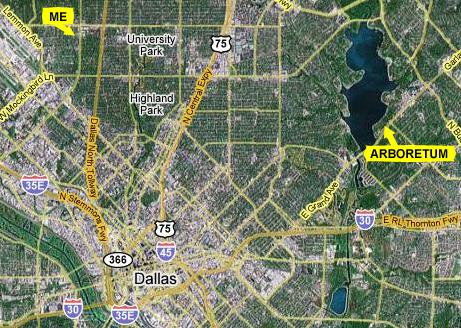 |
 |
The bike path used to cross the top of the dam, but for one reason or another, the bike path was rerouted a year ago, and now it goes through some parkland and playing fields south of the dam, across the spillway, up Garland Road for a ways, and then back north along the lake shore.
You can also see a closer view of the Arboretum in this picture, and can begin to pick out some of the pathways through the gardens.
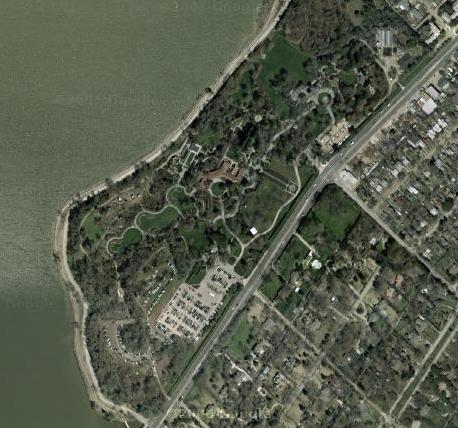 |
You can also see the maze of pathways that criss-cross the gardens.
We actually took Mockingbird Lane all the way across town and across the bridge at the top of White Rock Lake to Buckner Boulevard, which we took south to Gaston Avenue. Then we came back southwest to the main Arboretum entrance. We usually make a circular transit of the entire Arboretum each time we visit, and we will do that today. We'll start out by going across the north side of the gardens and back to the Lay Family Garden. We may go in the Rory Meyers Children's Garden but possibly not. We'll return to the entry along the Paseo de Flores, stopping in the test gardens, at the Frog Fountain and the Crepe Myrtle Allee and at the All America Selections Garden before returning to the entry.
|
1. Trammel Crow Entry Plaza
2. Jonsson Color Garden
3. A Woman's Garden (Phase 1)
4. A Woman's Garden (Phase 2)
5. Boswell Family Garden
6. Rudchik Red Maple Rill
7. Alex Camp House
8. Lay Family Garden
9. The Test Beds
and the Paseo de Flores
With that bit of orientation in mind, we can look at some of the many pictures we took on our visit today.
At the Trammel Crow Entry Plaza (1)
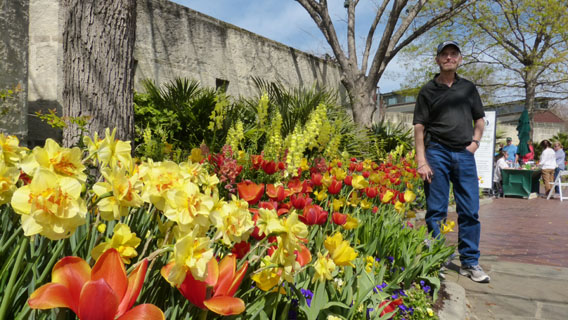 In the Entry Plaza |
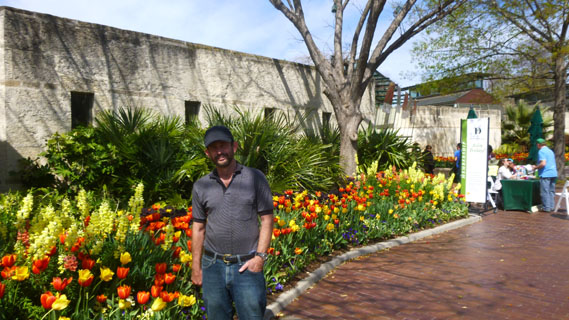 In the Entry Plaza |
Built with native Texas limestone and wood and copper sheathing, the structures here in the Entry Plaza serve as the gateway to the gardens.
|
The Plaza is surrounded by the information booth, classrooms, offices and facilities on your right, and the gift shop, meeting rooms and the cafe on your left. I think that one of the best times of the year for the Plaza is during the Fall Festival, when the entire plaza and the fountain are bordered by gourds and pumpkins of every size and description.
Today, though, its the late winter/early spring flowers that are taking center stage, and the plaza is all the better for it.
You won't see a picture of the Junkins Fountain today; we've photographed it numerous times before. We just headed off to our left, past the cafe, and down the stairs to the Fern Dell and Color Garden. Before we left the plaza, though, I had Fred pose for a series of pictures that I put together into this panorama:
 |
The Margaret Elisabeth Jonsson Color Garden (2)
|
It seems that most times, when we come to the Arboretum, we follow the walkway along the north side of the Color Garden; I suppose this is because most of the azaleas are on the north side of that walkway and this is a good way to see them when they are in bloom. We are just a bit early for them at this point, although some of the earliest varieties that were down by the bridge had started to put on their show. The Color Garden is home to more than 2,000 varieties of azaleas, which bloom lavishly in the spring.
We crossed the bridge, and Fred immediately took a picture of me looking back across the bridge towards the entry plaza; you can see that picture here.
At this time of year, "Dallas Blooms!" having just begun, the gardens sport mostly daffodils and tulips, along with the remainder of the pansies and ornamental kale and some other blooms that have made it through the winter.
|
To view the slideshow, just click on the image at right and I will open the slideshow in a new window. In the slideshow, you can use the little arrows in the lower corners of each image to move from one to the next, and the index numbers in the upper left of each image will tell you where you are in the series. When you are finished looking at the pictures, just close the popup window.
The Jonsson Color Garden changes dramatically throughout the year. Summer brings a vibrant display of bananas and tapioca plants, while autumn ushers in brightly colored chrysanthemums.
Just after you cross the bridge and begin walking along the north side of the Color Garden, you are passing an area the Arboretum calls "The Waterwise Display". This large, kidney-bean-shaped bed, donated by Region IV of the Texas Nursery and Landscape Association, provides a location for home gardeners to learn how to install and manage a low-water landscape- something of prime importance in this part of the country. Here are two views of this display:
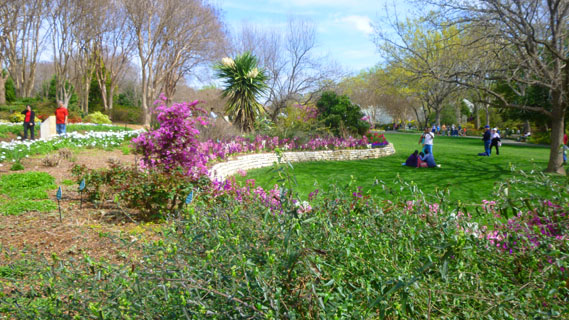 The Waterwise Display (looking east) |
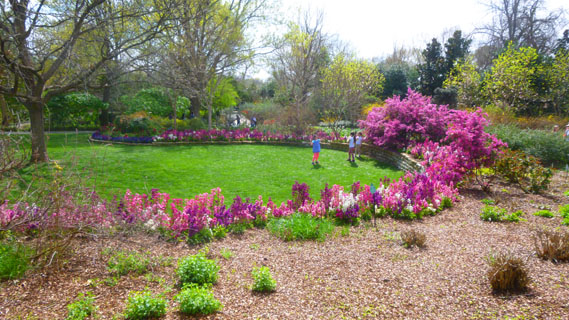 The Waterwise Display (looking west) |
Although we did not walk through it today (it being more of a summer thing), the Palmer Fern Dell lies between serves as a shady respite within the Color Garden, boasting a collection of ferns, camellias, azaleas and many other shade loving perennials and shrubs.
|
We took quite a few pictures as we walked around the Jonsson Color Garden, and I have put the best of these in the slideshow at right. Enjoy the Jonsson Color Garden!
To view the slideshow, just click on the image at left and I will open the slideshow in a new window. In the slideshow, you can use the little arrows in the lower corners of each image to move from one to the next, and the index numbers in the upper left of each image will tell you where you are in the series. When you are finished looking at the pictures, just close the popup window.
The individual pictures are pretty, of course, but creating more panoramic views shows the Jonsson Color Garden off to even better advantage. Here are a few such pictures we took or created:
 Looking South |
 Looking West |
 Looking South |
We continued walking along the north side of the Color Garden, wandering off occasionally if we saw some early azaleas blooming or to get a look at White Rock Lake. It was just a bit overcast, but a very nice day for early March.
|
|
A common sight in the Arboretum, pretty much year round, are young girls having photographs made for their Quinceañera. This Spanish tradition, also called "fiesta de quince años", is a celebration of a girl's fifteenth birthday, marking the transition from childhood to young womanhood. The celebrations today vary significantly across countries; celebrations in some countries, for example, have taken on more religious overtones than in others. From what we can see, the extent of the celebration is limited only by the family's financial resources. You will see some of these photo shoots in those pictures by the DeGolyer House.
A Woman's Garden (Phase 1) (3)
|
We always enjoy walking through A Woman's Garden; I like it for its symmetry, which is easy to see when you look in from the Jonsson Color Garden. There are benches to sit and relax and, of course, two commanding water features. Here are some of the pictures we took today in this part of the garden:
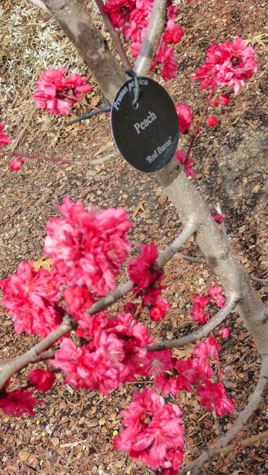 |
(Picture at left) Everyone has seen pear trees bloom, but peach trees in bloom are less well-known.
|
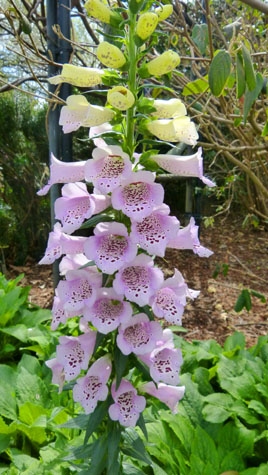 |
A Woman's Garden (Phase 2) (4)/Boswell Family Garden (5)
|

(Click Thumbnails to View) |
The Red Maple Rill (6)/Alex Camp House (7)
|
The Nancy Rutchik Red Maple Rill is a two-acre garden that boasts a fabulous collection of over 80 varieties of signature Japanese Maples planted along an artificial stream. (Personally, I think the stream is probably the Arboretum's best attraction and certainly its most intricate and engaging water feature.)
Key design elements of the Nancy Rutchik Red Maple Rill include a new entry off the Paseo de Flores and a large gathering plaza that overlooks a re-circulating creek and numerous waterfalls. The picture of the Red Maple Rill was taken from that space, and you can see a picture of me on this plaza at the top of the rill here.
Opened in fall 2011, this charming area also includes a series of paved walkways and a stone bridge connecting the Martin Rutchik Concert Stage to the Magnolia Allee. An especially large weeping Japanese maple, nearly 100 years old, anchors the center of the garden. When we got to the Paseo, we walked over by the Alex Camp House towards the Lay Garden. Beside the pool in front of the house we found a bronze sculpture of Mark Twain. We found out later that this was just one of a series being exhibited in the garden. We saw only some of them today, but returned a month hence with our friends Mario and Steve to see and photograph the rest of them.
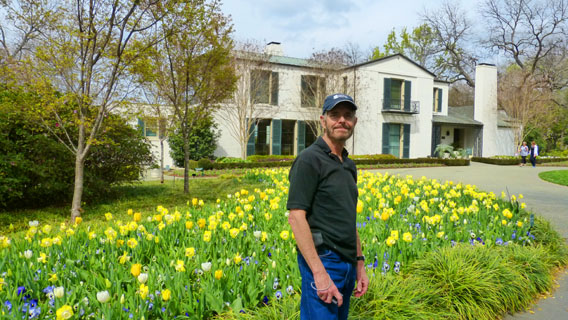 The Alex Camp House |
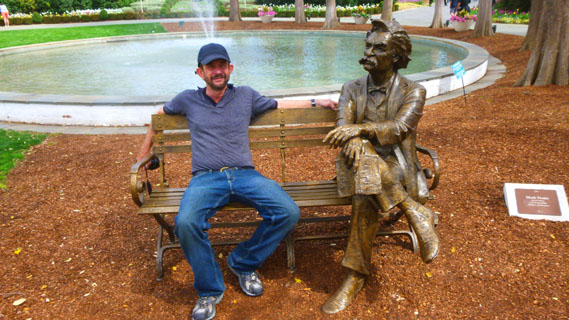 Fred Sitting with Mark Twain |
|
The Lay Family Garden (8)
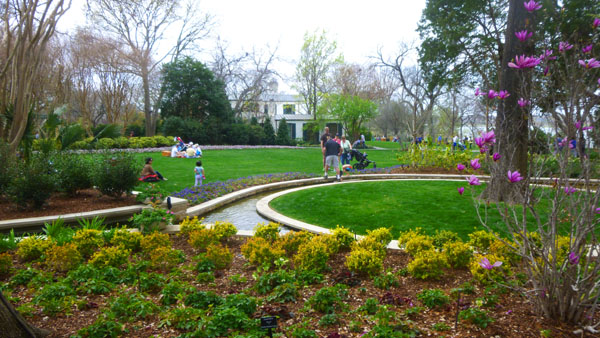 Looking West from the Koi Pond This view looks across the small lawn in the center of the Lay Garden towards the Alex Camp House- the building in the center of the picture. |
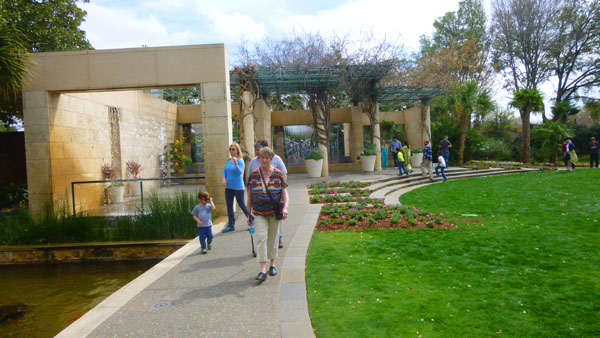 The Curtain Waterfalls This trio of waterfalls has been a staple of the Lay Garden since it opened- although the landscaping has changed. |
The recent renovation of the Lay Family Garden changed the traffic flow (in addition to the creation of Fossil Falls). An exit from the Lay Garden to the Rory Meyers Children's Garden needed to be created; this supplemented the walkway that in effect extends the Paseo de Flores (which actually ends in front of the Alex Camp House) all the way to the new Children's Garden. Visitors can go behind Fossil Falls to this new exit. New entrances to the Lay Garden were also made, to replace the kind of convoluted entrance that used to exist. One of these is beside the Alex Camp House and the other comes in off the walkway to the Meyers Garden.
|
The former entry to the Lay Garden has now become a pocket garden and more of a destination than a passageway. Here are more pictures from the Lay Family Garden:
 (Click Thumbnails to View) |
One of the most popular features of the Lay Family Garden has always been the native limestone walls with waterfalls cascading from them; these are directly across the large lagoon for aquatic plants from the grotto falls.
|
The waterfalls are certainly neat from the inside of the Lay Garden, but they are even more interesting when viewed from the other side. Part of the renovation of the Lay Garden added a new walkway that actuall goes behind the limestone walls, giving visitors a chance to look through the waterfalls into the Lay Garden itself. In the two pictures below, the left hand picture is a view looking through one of these waterfalls into the garden; the other is a view of that same waterfall looking out from the garden:
 (Click Thumbnails to View) |
While we were back behind the waterfalls, I happened to notice a beautiful redbud in full bloom, and I just had to photograph it. You can see that picture here.
|
The Arboretum has encouraged garden designers to add water features; the Lay Garden has four waterfalls, the pond for aquatic plants, a stream with three weirs and a Koi pond. Here are some additional pictures we in the Lay Garden- including one looking down into the Rory Meyers Children's Adventure Garden:
 |
From the Lay Family Garden, we walked back out to the circle in front of the Alex Camp House to head down the Paseo de Flores back towards the Arboretum entrance.
The Arboretum's Test Beds (9)
|

(Click Thumbnails to View) |
Adjacent to the long test beds are some rectangular ones where more shrub-like plants and flowers are tested; some of these beds are in shade so that quality can be evaluated as well. The Arboretum is quite good about labeling everything, so if Fred finds something he likes he can jot it down for further investigation. The labeling probably also helps some other Arboretum visitors know what's good and bad to eat.
|
To view the slideshow, just click on the image at left and I will open the slideshow in a new window. In the slideshow, you can use the little arrows in the lower corners of each image to move from one to the next, and the index numbers in the upper left of each image will tell you where you are in the series. When you are finished looking at the pictures, just close the popup window.
Enjoy wandering through the test beds!
The Paseo de Flores (10)
|
Designed by Luis Santana, the path begins at the Trammell Crow Visitor Education Pavilion and concludes near Fogelson Fountain, which was donated by the late Greer Garson in memory of her husband, Buddy, in front of the Alex Camp House. An extension of the walkway leads around the southeast side of the Lay Family Garden to reach the Rory Meyers Children's Adventure Garden. Along The Paseo, visitors can stop for photo opportunities and fun at the Magnolia Glade, the Crape Myrtle Allee, the Toad Corners Fountain, the Shadow Garden and the Pecan Grove.
There is a lot to do and see along the Paseo. There are food kiosks and two cafes, the DeGolyer House and other facilities. Near the Entry Pavilion is another set of trial gardens.
|

(Click Thumbnails to View) |
As we were walking back along the Paseo, we encountered two more of the bronze sculptures, and when I got back to the information desk I got a map for the rest of them, which we will return to see sometime soon.
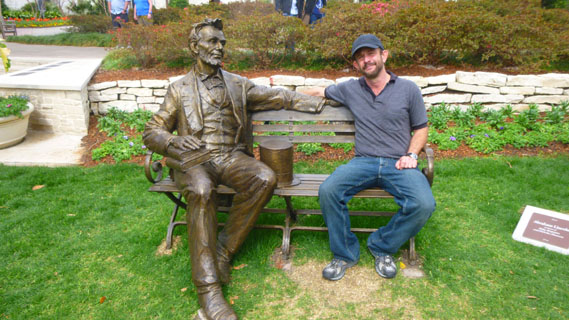 Fred and Abe Lincoln |
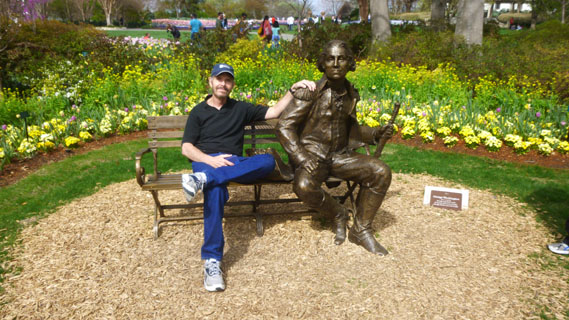 Me and George Washington |
As it turned out, not only were there bronze sculptures scattered throughout the garden, but there were performers scheduled as well, although we only encountered one.
|
The sculptures were all very interesting. Here is President Washington without anyone sitting next to him, and you can also see a close-up view of just his bust here. And here are a few more pictures we took along the Paseo:
 (Click Thumbnails to View) |
Just before you get back to the Trammel Crow Pavilion, you pass another set of test gardens on the left. These beds are part of a nationwide network of trial gardens run by All-America Selections.
|
The Trial Gardens at the Dallas Arboretum were created for the purpose of expanding its research efforts and providing information to the public. The focus of the trial program is to grow and evaluate many different plants in the drastic climate of the Metroplex and North Central Texas. Information generated from the trials is provided to commercial plant producers, retailers and home gardeners. Between 3,000 and 5,000 plants are trialed yearly from over 150 plant breeding companies.
The trial garden is part of the All-America Selections program; a non-profit organization encourages gardens in different areas of the country to undertake these programs, and the information gleaned is shared through that organization with garden clubs, garden centers and the public.
Just before we left the Arboretum, I picked up a map of the eight bronze sculptures so we could visit the rest of them next time, and we made a stop in the gift shop. They were selling scaled down bronze miniatures of some of the sculptures, including this one of Henri Matisse. Since Prudence likes art, I thought of getting it for her for Christmas this year, but the $6000 price tag was just a bit too daunting. We enjoyed our visit to Dallas Blooms!, and we plan to return sometime after our trip to Florida next week to catch the rest of the sculptures and to see if the azaleas are in full bloom.
You can use the links below to continue to another photo album page.
 |
March 9-28, 2016: A Trip to Fort Lauderdale |
 |
February 26-29, 2016: A Weekend in San Antonio |
 |
Return to the Index for 2016 |